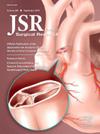结肠直肠手术后阿片类药物的长期使用
IF 1.8
3区 医学
Q2 SURGERY
引用次数: 0
摘要
美国继续与阿片类药物流行病作斗争。增强术后恢复(ERAS)途径旨在限制阿片类药物在围手术期的使用。本研究的目的是检查标准化的非麻醉性药物是否与opioid-naïve患者结直肠手术后长期阿片类药物使用的减少有关。材料和方法本研究为2017 - 2020年回顾性队列研究,随访时间为1年。数据摘自美国外科医师学会国家手术质量改进计划和Epic系统合作项目,来自麻省总医院布里格姆结直肠手术协作组的五个机构。阿片类药物naïve接受结直肠手术的患者使用标准化的现行程序术语代码进行选择。在2017年至2020年期间,所有五个站点都制定了标准化的ERAS协议。主要结局是术后长期阿片类药物使用,定义为6岁和12岁时持续使用阿片类药物。结果共纳入1363例opioid-naïve结肠直肠手术患者。从2017年到2020年,几乎所有患者都服用了阿片类药物。2017年至2018年,16%和11%的患者分别在6个月和12个月时继续使用阿片类药物,而2018年至2019年,这一比例分别为15%和8%,2019年至2020年,这一比例分别为11%和4%。0.01.结论:虽然有小部分opioid-naïve患者在术后1年仍使用阿片类药物,但我们发现,在ERAS通路中阿片类药物节约策略标准化后,从2017年到2020年,阿片类药物使用量逐步减少。本文章由计算机程序翻译,如有差异,请以英文原文为准。
Long-Term Opioid Use After Colon and Rectal Surgery
Introduction
The United States continues to struggle with the opioid epidemic. Enhanced recovery after surgery (ERAS) pathways aim to limit opioid use in the perioperative setting. The goal of this study was to examine whether standardized, nonnarcotic medications are associated with a decrease in long-term opioid use after colorectal surgery in opioid-naïve patients.
Materials and methods
This was a retrospective cohort study from 2017 to 2020 with 1 y duration of follow-up. Data were abstracted from the American College of Surgeons National Surgical Quality Improvement Program and Epic Systems Cooperation from five institutions in the Mass General Brigham Colorectal Surgery Collaborative. Opiate naïve patients undergoing colorectal surgery were selected using standardized Current Procedural Terminology codes. Between 2017 and 2020, a standardized ERAS protocol was developed at all five sites. The primary outcome was long-term opioid use after surgery defined as persistent opioid use at 6 and 12 mo.
Results
A total of 1363 opioid-naïve patients undergoing colorectal surgery were included in the study. From 2017 to 2020, nearly all patients were prescribed opioids. From 2017 to 2018, 16% and 11% of patients continued to use opioids at 6 and 12 mo, respectively, compared to 15% and 8% of patients from 2018 to 2019, and 11% and 4% of patients from 2019 to 2020, P < 0.01.
Conclusions
Although a small proportion of opioid-naïve patients remain on opioids at 1 y postoperatively, we show a stepwise reduction from 2017 to 2020 after standardization of opioid-sparing strategies in ERAS pathways.
求助全文
通过发布文献求助,成功后即可免费获取论文全文。
去求助
来源期刊
CiteScore
3.90
自引率
4.50%
发文量
627
审稿时长
138 days
期刊介绍:
The Journal of Surgical Research: Clinical and Laboratory Investigation publishes original articles concerned with clinical and laboratory investigations relevant to surgical practice and teaching. The journal emphasizes reports of clinical investigations or fundamental research bearing directly on surgical management that will be of general interest to a broad range of surgeons and surgical researchers. The articles presented need not have been the products of surgeons or of surgical laboratories.
The Journal of Surgical Research also features review articles and special articles relating to educational, research, or social issues of interest to the academic surgical community.

 求助内容:
求助内容: 应助结果提醒方式:
应助结果提醒方式:


